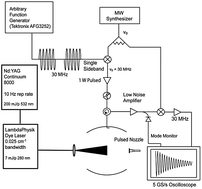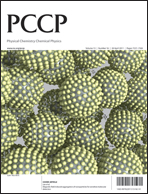Recent advances in the technology of test and measurement equipment driven by the computer and telecommunications industries have made possible the development of a new broadband, Fourier-transform microwave spectrometer that operates on principles similar to FTNMR. This technique uses a high sample-rate arbitrary waveform generator to construct a phase-locked chirped microwave pulse that gives a linear frequency sweep over a wide frequency range in 1 μs. The chirped pulse efficiently polarizes the molecular sample at all frequencies lying within this band. The subsequent free induction decay of this polarization is measured with a high-speed digitizer and then fast Fourier-transformed to yield a broadband, frequency-resolved rotational spectrum, spanning up to 11.5 GHz and containing lines that are as narrow as 100 kHz. This new technique is called chirped-pulse Fourier transform microwave (CP-FTMW) spectroscopy. The technique offers the potential to determine the structural and dynamical properties of very large molecules solely from fully resolved pure rotational spectra. FTMW double resonance techniques employing a low-resolution UV laser facilitate an easy assignment of overlapping spectra produced by different conformers in the sample. Of particular interest are the energy landscapes of conformationally flexible molecules of biological importance, including studies of their interaction with solvent and/or other weakly bound molecules. An example is provided from the authors' work on p-methoxyphenethylamine, a neurotransmitter, and its complexes with water.

You have access to this article
 Please wait while we load your content...
Something went wrong. Try again?
Please wait while we load your content...
Something went wrong. Try again?


 Please wait while we load your content...
Please wait while we load your content...